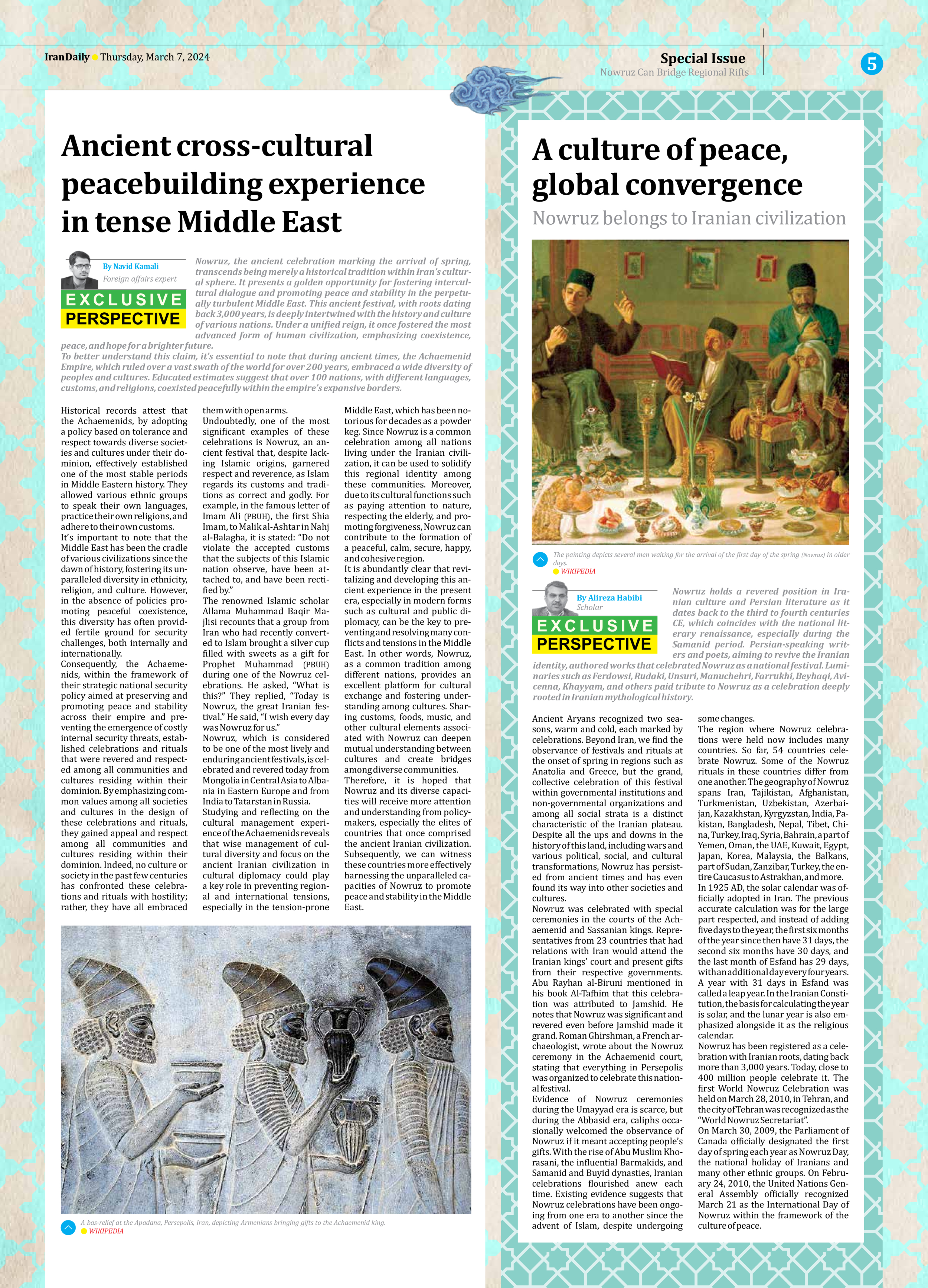
Ancient cross-cultural peacebuilding experience in tense Middle East
By Navid Kamali
Foreign affairs expert
Nowruz, the ancient celebration marking the arrival of spring, transcends being merely a historical tradition within Iran’s cultural sphere. It presents a golden opportunity for fostering intercultural dialogue and promoting peace and stability in the perpetually turbulent Middle East. This ancient festival, with roots dating back 3,000 years, is deeply intertwined with the history and culture of various nations. Under a unified reign, it once fostered the most advanced form of human civilization, emphasizing coexistence, peace, and hope for a brighter future.
To better understand this claim, it’s essential to note that during ancient times, the Achaemenid Empire, which ruled over a vast swath of the world for over 200 years, embraced a wide diversity of peoples and cultures. Educated estimates suggest that over 100 nations, with different languages, customs, and religions, coexisted peacefully within the empire’s expansive borders.
Historical records attest that the Achaemenids, by adopting a policy based on tolerance and respect towards diverse societies and cultures under their dominion, effectively established one of the most stable periods in Middle Eastern history. They allowed various ethnic groups to speak their own languages, practice their own religions, and adhere to their own customs.
It’s important to note that the Middle East has been the cradle of various civilizations since the dawn of history, fostering its unparalleled diversity in ethnicity, religion, and culture. However, in the absence of policies promoting peaceful coexistence, this diversity has often provided fertile ground for security challenges, both internally and internationally.
Consequently, the Achaemenids, within the framework of their strategic national security policy aimed at preserving and promoting peace and stability across their empire and preventing the emergence of costly internal security threats, established celebrations and rituals that were revered and respected among all communities and cultures residing within their dominion. By emphasizing common values among all societies and cultures in the design of these celebrations and rituals, they gained appeal and respect among all communities and cultures residing within their dominion. Indeed, no culture or society in the past few centuries has confronted these celebrations and rituals with hostility; rather, they have all embraced them with open arms.
Undoubtedly, one of the most significant examples of these celebrations is Nowruz, an ancient festival that, despite lacking Islamic origins, garnered respect and reverence, as Islam regards its customs and traditions as correct and godly. For example, in the famous letter of Imam Ali (PBUH), the first Shia Imam, to Malik al-Ashtar in Nahj al-Balagha, it is stated: “Do not violate the accepted customs that the subjects of this Islamic nation observe, have been attached to, and have been rectified by.”
The renowned Islamic scholar Allama Muhammad Baqir Majlisi recounts that a group from Iran who had recently converted to Islam brought a silver cup filled with sweets as a gift for Prophet Muhammad (PBUH) during one of the Nowruz celebrations. He asked, “What is this?” They replied, “Today is Nowruz, the great Iranian festival.” He said, “I wish every day was Nowruz for us.”
Nowruz, which is considered to be one of the most lively and enduring ancient festivals, is celebrated and revered today from Mongolia in Central Asia to Albania in Eastern Europe and from India to Tatarstan in Russia.
Studying and reflecting on the cultural management experience of the Achaemenids reveals that wise management of cultural diversity and focus on the ancient Iranian civilization in cultural diplomacy could play a key role in preventing regional and international tensions, especially in the tension-prone Middle East, which has been notorious for decades as a powder keg. Since Nowruz is a common celebration among all nations living under the Iranian civilization, it can be used to solidify this regional identity among these communities. Moreover, due to its cultural functions such as paying attention to nature, respecting the elderly, and promoting forgiveness, Nowruz can contribute to the formation of a peaceful, calm, secure, happy, and cohesive region.
It is abundantly clear that revitalizing and developing this ancient experience in the present era, especially in modern forms such as cultural and public diplomacy, can be the key to preventing and resolving many conflicts and tensions in the Middle East. In other words, Nowruz, as a common tradition among different nations, provides an excellent platform for cultural exchange and fostering understanding among cultures. Sharing customs, foods, music, and other cultural elements associated with Nowruz can deepen mutual understanding between cultures and create bridges among diverse communities.
Therefore, it is hoped that Nowruz and its diverse capacities will receive more attention and understanding from policymakers, especially the elites of countries that once comprised the ancient Iranian civilization. Subsequently, we can witness these countries more effectively harnessing the unparalleled capacities of Nowruz to promote peace and stability in the Middle East.







